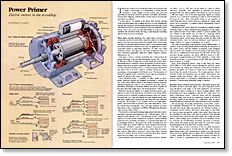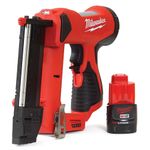
Synopsis: Electrical engineer Edward J. Cowern explains how electric motors work, why they might stop working, and how you can intelligently choose new ones to use as replacements or incorporate in the machines you build. His information is designed to help you make sensible, safe decisions when choosing, connecting, and operating electric motors in your workshop. Cowern discusses various motor types, enclosure types, frame size and mounting, and motor controls. He also covers maintenance and troubleshooting. Side information tackles the meaning of horsepower and the mysteries of horsepower rating standards.
There was a time not too long ago when a woodworker had to open a sluice gate to a waterwheel or stoke the fire beneath a steam engine’s boiler before any powered machinery in the shop could be operated. Nowadays, the relative luxury of just flipping a switch makes electric motors an essential part of the woodshop.
In this article, I’ll explain a bit about how electric motors work, why they might stop working and how you can intelligently choose new motors to use as replacements or incorporate in the machines you build. I won’t attempt to entirely demystify motor theory, but I can convey enough knowledge to help you make sensible, safe decisions when choosing, connecting and operating electric motors in your workshop.
Motor types—Broadly speaking, two major types of motors are commonly used by woodworkers: induction motors for stationary power tools, and universal motors for portable tools. A third type, the direct-current permanent-magnet motor, is becoming popular for battery-operated cordless tools and in applications where controlled speed is important. However, I’ll deal only with induction motors (see figure 1), the basic workhorse found on most stationary equipment—tablesaws, lathes, shapers, jointers, drill presses, etc.
This type of motor converts electricity into rotary motion by taking advantage of the fact that alternating current (AC) reverses its direction of flow 60 times per second. Inside the motor, these alternating electric impulses reverse the polarity of a fixed electromagnet, the stator, around a cylindrical drum called a rotor. These current reversals actually produce a rotating magnetic field inside the stator which, in turn, induces currents inside the rotor, producing a strong magnetic field in the rotor. The interaction of these two magnetic fields causes the rotor to spin as it attempts to match the speed of the stator’s rotating field.
Since electrical power is available in either single or three phase, induction motors are designed specifically to operate on one or the other. “Phase” refers to the number of pulses of power delivered during one cycle ( of a second for 60-cycle power). Therefore, three-phase electricity delivers six pulses of power in the same time that single-phase electricity produces only two.
Whether you choose single- or 3-phase induction motors may depend on what kind of power is available to your shop. When 3-phase power is available, usually in industrial areas, use 3-phase motors if you can. They are simpler and have longer service lives than their single-phase equivalents, and they are more efficient to operate. It’s possible to use 3-phase motors on single-phase power, but you’ll need to provide your own third phase. There are several ways of doing this. One is the type of phase converter described by Mac Campbell in FWW on Woodworking Machines (The Taunton Press, 1985).
From Fine Woodworking #64
For the full article, download the PDF below:
Fine Woodworking Recommended Products

Festool Cleantec CT 26 E HEPA Dust Extractor

Milwaukee M12 23-Gauge Cordless Pin Nailer

Festool DF 500 Q-Set Domino Joiner






















Comments
Nice, useful article. Thank you.
Log in or create an account to post a comment.
Sign up Log in